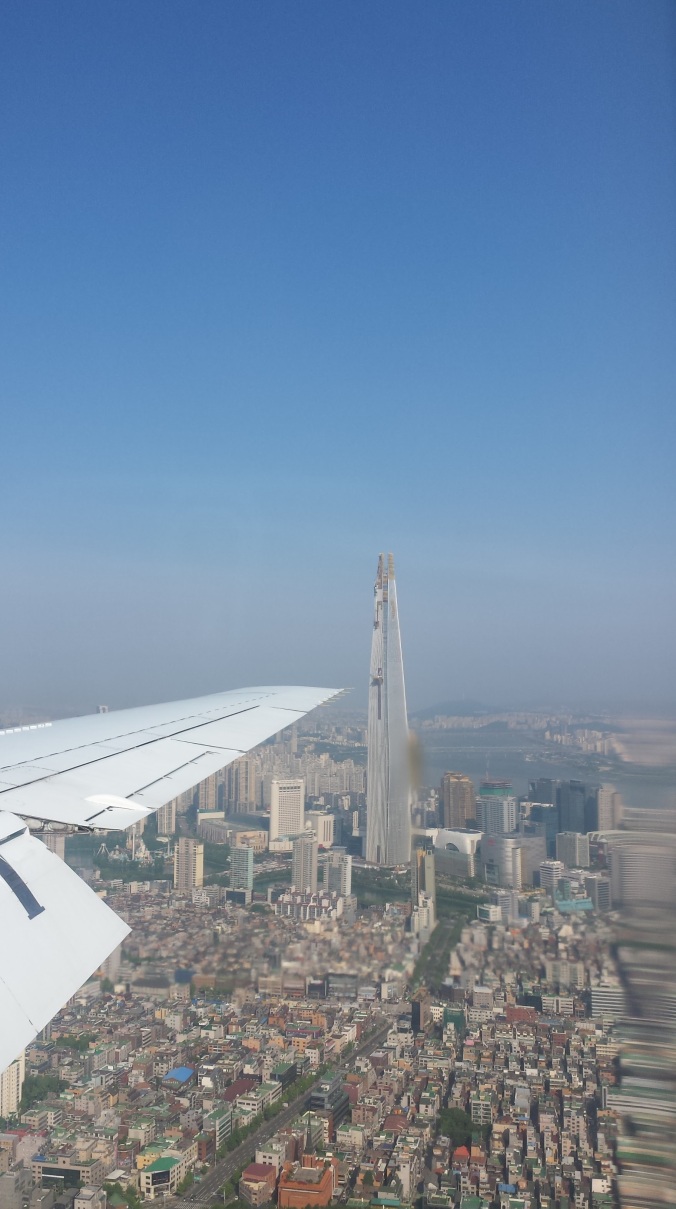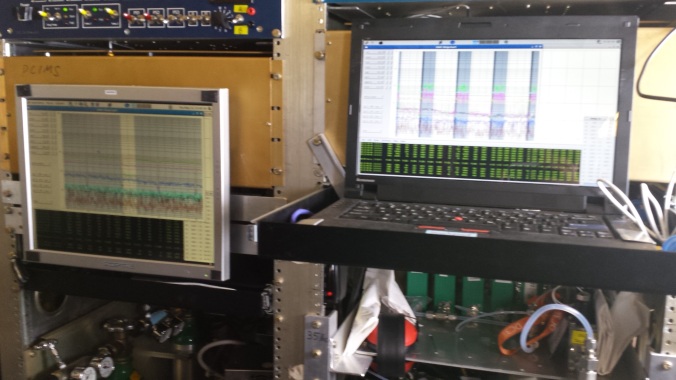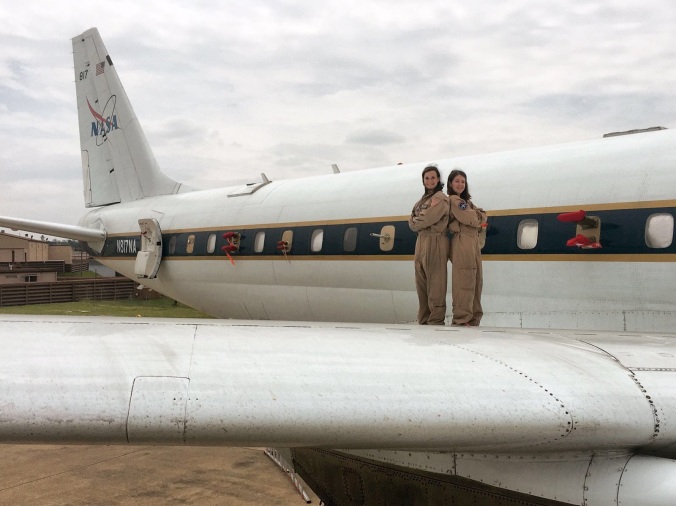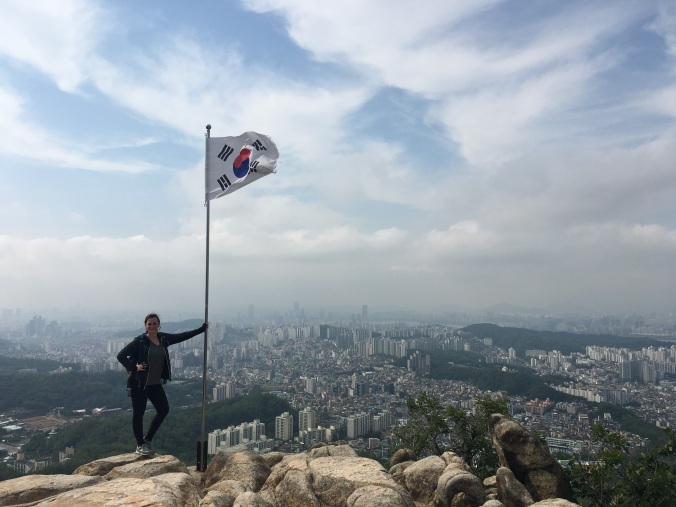As you know, we have a variety of great research happening at EAS. Many graduate and undergraduate students are invited to participate in field work related to research and they return to campus with great stories. We’re going to start sharing some of those stories in their own words here.
Our first student is undergraduate Maddi Frank. Maddi accompanied Dr. Greg Huey on a fieldwork trip to Korea earlier this summer. Read on to find out more about her, her experiences there, and what advice she has for students who are coming into the EAS major this fall.
What year are you?
I am a rising 5th year/senior graduating in December 2016.
What was the purpose of your research in Korea?
Our mission was part of the KORUS-AQ (KOrea U.S. – Air Quality) program. KORUS-AQ is a field study with three main objectives. The first objective was to analyze the air quality and distribution of emissions both within South Korea and above the surrounding waters along the Asian Pacific Rim. This was achieved primarily with data gathered both from ground monitoring stations and several flights on a DC-8 aircraft repurposed by NASA to carry up to 25,000lbs of science instrumentation. The second objective was to analyze the locations, sources, and concentration of pollutants in air containing particularly heavy pollution loads. The hope is that this information and the models we can create with it result in a better understanding of how to focus our resources when tackling the pollution problem. Currently, the sources and mechanisms of air pollution transport through the atmosphere above Seoul remain something of a mystery. The third objective was to foster the relationship between the Korean and American governments, both of which share the goals of improving air quality and refining the technology used to study it. For example, previous measurements of air quality taken by LEO (Low Earth Orbit) satellites were low resolution and long in between each measurement – around once a day. To address this poor resolution, the development of a GEO (Geosynchronous Equatorial Orbit) satellite program is taking place thanks to resources contributed by the Koreans and the Americans. The first satellite is expected to be launched within the next few years. The hope is that greater engagement and cooperation between Korean and American science organizations would set the stage for future science collaboration, not only on air quality issues but in other fields of study as well.

Seoul, Korea as seen on a day with relatively low air pollution. Taken from NASA’s DC-8 aircraft used to fly missions for KORUS-AQ, a joint Korean-American program intended to study air quality in the Seoul Metro Area. Photo courtesy of Maddi Frank.

Seoul, Korea as seen on a day experiencing high levels of air pollution. This picture and the previous picture were taken in the same area, illustrating the severity with which air pollution can affect the city. Photo courtesy of Maddi Frank.
During the flight, much the data we collected was presented on a monitor. This monitor essentially displayed our data in real time, which allowed us to communicate with the other scientists on board when we flew through areas with high concentrations of sulfur dioxide or PAN (both toxic substances in the air). The structure of the project was quite multifaceted in this way. There was so much coordination between the teams involved with ground/in-situ measurements, satellite, geostationary satellite observations, modeling – it was incredible to see! The NASA KORUS-AQ white paper linked here goes into more detail about what kinds of scientists were involved and the science questions we were attempting to answer with this project.
What was your specific role on the project?
Most of our work took place on the research aircraft and my specific role onboard was to help support the construction of the instruments (or to adapt preexisting instruments for the purposes of this mission). The instrument our group built and operated is called a CIMS (Chemical Ionization Mass Spectrometer). It works by capturing ambient air from outside the aircraft and directing it through a space where it can be analyzed. Once inside the CIMS, the particular species of pollutant that we were trying to measure was ionized by a reagent ion through a chemical reaction. From there, the mass spectrometer detected the gas in question because molecules of the ionized gas will follow a certain path, so to speak, based on their individual masses.

The Georgia Tech CIMS machine used on the KORUS-AQ mission. A Chemical Ionization Mass Spectrometer designed and built at Dr. Greg Huey’s lab used to analyze different gases present in the air in and around Seoul. Photo courtesy of Maddi Frank.
It was also my job to help with the maintenance of the instruments, which included calibrating the different flows associated with each instrument (inlet flows, calibration gas flows, etc.) This was important because we would need to take into account any calibrations that did not appear as a linear correlation with corresponding voltage values. Failing to do this would greatly disrupt the processing of our data. I also helped change out any gas cylinders needed for operation (those things are heavy!) and other general maintenance.
During the flights, which usually lasted eight or nine hours, Dr. Huey and GT Research Technologist Dave Tanner would teach us about the chemical mechanisms at play and any implications of the spikes in the gases we were measuring. This provided so much valuable knowledge that I would not have been able to get otherwise. I also helped document any changes made to the instruments or any issues that we faced.
Did anything unexpected happen while you were there? If so, how did you deal with it?
Flying on the aircraft wasn’t always so pleasant. We flew very low (500ft above water or 1000ft above land) for extended periods of time, which made the cabin in the aircraft very hot. Also, flying so low means flying in/through the Boundary Layer, which is often very bumpy. Korea’s terrain is quite rugged as well, which made flying even bumpier than normal at times. But it was always cool to go hang out in the cockpit with the pilots or roam around the airplane to see the other instruments operating and collecting data. It was also very interesting to see the science in real time, meaning that the instruments that WE built were working and we could see the chemistry happening right before our eyes!

Maddi Frank and Maddie Nisi in their flight suits preparing for a flight on NASA’s DC-8 research plane in Seoul, Korea. Photo courtesy of Maddi Frank.
I was also surprised at just how poor the air quality was there! The difference in visibility between days with high pollution vs those with low pollution was shocking! I also physically felt the effects of being there and breathing in all the polluted air. I noticed after a few days that my throat would hurt in the morning, and I even had a slight cough and congestion! Being there for an entire month, I feel like I eventually acclimated, but still! The people who live and work there have to breathe all that in everyday!
Did you have any down time to explore the area you stayed in?
I did have time to explore actually! We usually had one hard down day per week. My friend and co-worker Madison (Maddie) Nisi (yes, we were known as the Maddi(e)s with the people we worked with) and I took advantage of these days to go explore Seoul, go hiking, and travel down to Busan (a beach city on the southeastern part of the peninsula). We quickly mastered the amazing public transportation there. We would wander around Seoul to take in the life and culture there. It was awesome! We had many people point us in the right direction when we looked lost, and they were always willing to recommend places that we should go! On one of our days off, we went to a palace called Gyeongbokgung. It was beautiful, and so big! We wandered around there for an entire day, making sure we went through every door. We also saw live traditional music and dancing there, which was interesting.
On another day off, we went hiking just outside of Seoul. It was funny because if you went hiking here in Atlanta, you’d have to drive an hour or so out of the city. But there, the subway takes you almost right to the trailhead. It was a very rocky hike, but with beautiful views of Seoul!

Hiking outside of Seoul during a day off. Photo courtesy of Maddi Frank.
We were also staying on Osan Air Base, which is an American air force base in Pyeongtaek, South Korea, and we were able to explore around there. Just off base was a small town called Songtan which had a ton of fun restaurants, vendors, shops, bars, etc! We would frequently venture out there for dinner. We even made friends with some of the airmen and airwomen who were stationed at Osan AB! We spent a lot of time with other scientists who were participating on the mission as well and got to hear funny stories about past missions they had been on together.
How did you come to be involved in Dr. Huey’s research in Korea?
I’ve been working for Dr. Huey in his lab for 2 years. This is the 2nd science field mission I have done with him as part of the lab. The first was when the lab was funded for a project called FRAPPE (Front Range Air Pollution and Photochemistry Experiment) out in Colorado. I got to spend my summer out there, and that was my first science field mission project! But that was on the C-130 aircraft, which is not nearly as smooth or as nice as the DC-8. When we got funded for the KORUS-AQ project, he asked if I wanted to go out to Korea for some time and help out, and, of course, I said yes! I got to work closely with him and Dave Tanner while I was out there, and learned so much from them.
Do you have any advice for incoming freshmen/transfer students?
Absolutely! First, it’s okay if you don’t know what you want to do right away. Even if you think you do, always keep an open mind! You are in school (a widely esteemed school at that) to learn and see what’s out there for you! I thought I wanted to be an aerospace engineer for almost my whole life. When I got involved in the curriculum, however, I saw that it wasn’t for me. I decided to switch my major to EAS (meteorology) with the hopes of entering the aviation/aviation meteorology field. There is more than one path to get where you want to go.
Second, absolutely get involved with research!!!! The department you’re in doesn’t matter, research is always available. There are so many benefits! You get to work closely with awesome faculty/staff and build a relationship with them that could be very useful to you later on! They can potentially become your professor or advisor, and even provide you with recommendation letters or connections when it’s time to apply for jobs or grad school!
Research is also great because you can receive course credit or a paycheck. You also get a hands-on learning and work experience that you wouldn’t otherwise get. Having that experience allows you to see if it’s something you may want to pursue further in your academic or post-academic career. You might also get to travel and do research in a foreign country one summer while getting paid!
Third, get involved with your research early. Professors are more than willing to take freshmen and sophomores/transfers. I hadn’t even taken a single EAS class when I started doing research with Dr. Huey. Research in other departments is also a possibility. There are always collaborations between departments going on. It’s as easy as emailing a professor whose research interests you and asking to meet with them about it. I promise it will enrich your learning experience and time here at GT.
That said, I also recommend getting involved with anything else you may be interested in early on so you have time to enjoy it! It’s okay to take less than 18 credit hours if you cannot handle it. You are smart, that is why you are here, but make sure to put yourself first and put yourself in a position to succeed while still staying healthy and enjoying the college experience.
Finally, make friends in your major! EAS is lucky because we have a small student body; we’re all friends. We are willing to help each other or always study together. Regardless, try to find at least ONE person in each class you take with whom you can study and work through homework problems.